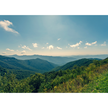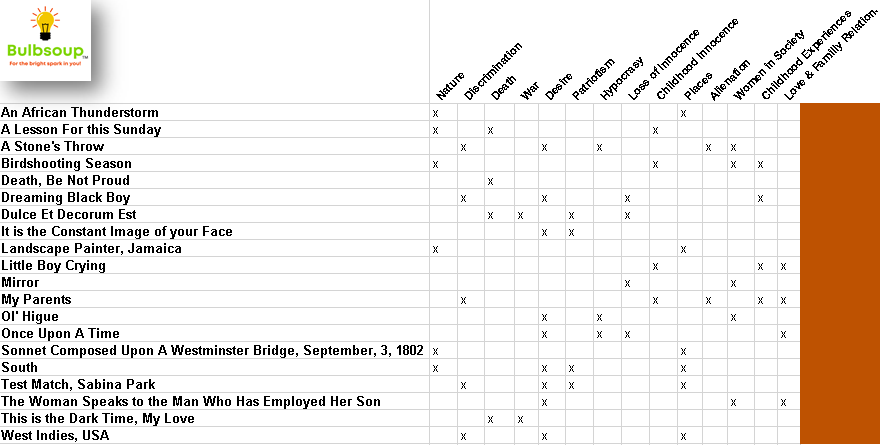Sentry Page Protection
LANDSCAPE PAINTER, JAMAICA
|
|
Vivian Virtue (13 November 1911 – 17 December 1998) was a Jamaican poet, translator, and broadcaster who moved to England in 1960. He served as the assistant secretary, librarian, and later vice-president of the Poetry League of Jamaica. (more)
|
LITERAL MEANING
The speaker watches the landscape painter setting up his easel in a corner of the twisted mountain track. The painter's brush busily paints the mountains, which are grouped like a family. He watches (www.bulbsoup.com) the painter observing what he is about to paint, but the painter appears to have some frustration over his inability to capture the perfection of the mountains.
The speaker watches the landscape painter setting up his easel in a corner of the twisted mountain track. The painter's brush busily paints the mountains, which are grouped like a family. He watches (www.bulbsoup.com) the painter observing what he is about to paint, but the painter appears to have some frustration over his inability to capture the perfection of the mountains.
|
I watch him set up easel,
Both straddling precariously A corner of the twisted, 6. climbing Mountain track. 5 1. A tireless humming-bird, his brush 7. Dips, darts, hovers now here, now there, Where 2. puddles of pigment Bloom in the palette's wild small garden. 3. The mountains pose for him 10 In a family group - Dignified, self-conscious against the 1. wide blue screen Of morning; low green foot-hills 4. Sprawl like grandchildren about the knees Of seated elders. And behind them, 3. aloof, 15 Shouldering the sky, patriarchal in serenity, 8. Blue Mountain Peak bulks. And the 9. professional gaze Studies position, impatiently waiting For the perfect moment to fix 20 10. Their preparedness, to confine them For the pleasant formality Of the family album. 1. His brush a humming-bird Meticulously poised ... 25 3. The little hills fidgeting 5 Changelessly changing, 11. Artlessly frustrating The painter's art. Poet: Vivian Virtue |
LITERARY DEVICES
1. METAPHOR
|
4. SIMILE
- Stanza 3, line 13: shows the position of the foothills, in relation to Blue Mountain. They are surrounding the mountain. The simile allows the reader to visualize size, small versus large. The grandchildren versus the grandfather. So proportion and size are emphasized through this simile.
- Stanza 5, line 26: is an absolutely beautiful way to highlight the fact that the hills change, based on the position that it is viewed from. So, it is not really moving, it is the painter that moves, but when he does, he gets a new vantage point that allows him to appreciate another aspect of the hills and the mountains. This oxymoron highlights how the position from which we view things affects our perception of that thing, in this case, it is the hills and the mountains.
IMPORTANT WORDS/ PHRASES
6. 'Climbing Mountain track' (Stanza 1, lines 3-4)
This phrase emphasizes height. The use of the continuous tense literally allows the reader to perceive movement and height, constant upward advancing. The result is that we can then visualize not only a tall incline but a dangerous one as well.
7.'Dips, darts, hovers now here, now there' (Stanza 2, line 6)
This is the literal movement of the painter's hands and therefore the action of the brush. It conveys passion because the movement is so dartish, with a frantic edge to it. The painter is absorbed in the process of creation, or recreating what he is seeing.
8. 'Blue Mountain Peak bulks' (Stanza 3, line 16)
The word bulk, as a noun, means the mass or size of something. The poet, interestingly, turns this word into a verb. The effect of this transformation is that size and mass are conveyed, continuously. So movement, juxtaposed with size, is constantly emphasized in this poem. Essentially, we are given a visual image, in term of the sheer size, of the mountain
9. professional gaze (Stanza 4, line 17)
This speaks to the manner in which the persona observes the scenery. He isn't just looking in a cursory, observational manner, he is assessing with an artist's gaze, paying attention to colours and textures.
10. Their preparedness, to confine them (Stanza 4, line 20)
This phrase is referring to when the artist transfers what he sees to canvas. The image is literally confined and unchanging.
11. Artlessly frustrating the painter's art (Stanza 5, line 28)
This is a beautiful turn of phrase that speaks to the idea that the artist can never truly capture what he sees. This is because at every moment, what the artist captures changes. What he captured is, essentially, in the past. The mountain, for example, looks different every second of the day, based on how the light affects it. So the view that he captures at 1:40, is not the same view at 1:45.
6. 'Climbing Mountain track' (Stanza 1, lines 3-4)
This phrase emphasizes height. The use of the continuous tense literally allows the reader to perceive movement and height, constant upward advancing. The result is that we can then visualize not only a tall incline but a dangerous one as well.
7.'Dips, darts, hovers now here, now there' (Stanza 2, line 6)
This is the literal movement of the painter's hands and therefore the action of the brush. It conveys passion because the movement is so dartish, with a frantic edge to it. The painter is absorbed in the process of creation, or recreating what he is seeing.
8. 'Blue Mountain Peak bulks' (Stanza 3, line 16)
The word bulk, as a noun, means the mass or size of something. The poet, interestingly, turns this word into a verb. The effect of this transformation is that size and mass are conveyed, continuously. So movement, juxtaposed with size, is constantly emphasized in this poem. Essentially, we are given a visual image, in term of the sheer size, of the mountain
9. professional gaze (Stanza 4, line 17)
This speaks to the manner in which the persona observes the scenery. He isn't just looking in a cursory, observational manner, he is assessing with an artist's gaze, paying attention to colours and textures.
10. Their preparedness, to confine them (Stanza 4, line 20)
This phrase is referring to when the artist transfers what he sees to canvas. The image is literally confined and unchanging.
11. Artlessly frustrating the painter's art (Stanza 5, line 28)
This is a beautiful turn of phrase that speaks to the idea that the artist can never truly capture what he sees. This is because at every moment, what the artist captures changes. What he captured is, essentially, in the past. The mountain, for example, looks different every second of the day, based on how the light affects it. So the view that he captures at 1:40, is not the same view at 1:45.
THEMATIC CATEGORY: Nature, Places
MOOD/ ATMOSPHERE
The mood of the poem is generally reflective.
The tone of the poem is calm.
The mood of the poem is generally reflective.
The tone of the poem is calm.
Contributor: Leisa Samuels-Thomas
Virtue, Vivian. 'Landscape Painter, Jamaica' in A World of Poetry. Edited by Mark McWatt and Hazel Simmonds McDonald. Pearson Education Ltd, 2005
Virtue, Vivian. 'Landscape Painter, Jamaica' in A World of Poetry. Edited by Mark McWatt and Hazel Simmonds McDonald. Pearson Education Ltd, 2005







